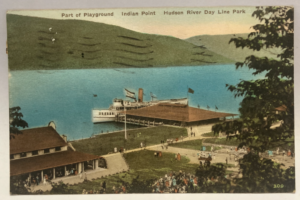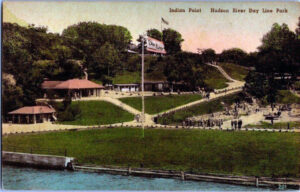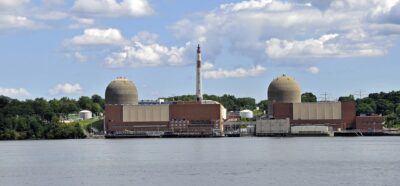Indian Point, located on the east shore of the Hudson River just below Peekskill, has a fascinating history that spans several decades and reflects the changing dynamics of the time.
The Hudson River Day Line Company, a key player in river travel, found itself in a competitive landscape with the rise of railroad and automobile travel. In a strategic move to boost ticket sales for their ships, the company decided to open an amusement and pleasure park near New York City. This led to the purchase of 320 acres of land in Buchanan, NY, along the Hudson River in 1923, giving birth to Indian Point Park.
The park was designed to rival Bear Mountain Park across the river. Initially, it offered visitors natural attractions such as a riverfront beach, walking trails, and a lake for rowing. Additionally, the park provided amenities, including picnic areas, food vendors, ball fields, and swings. However, in 1929, the park expanded to include a swimming pool, amusement rides, a dance hall, a beer hall, and miniature golf, all aimed at attracting more visitors. It was a respite from the crowded city and a day out along the river for city dwellers.
At its zenith, the park drew up to 10,000 weekend visitors. The Hudson River Day Line operated the park until 1948 when it closed. Emanuel Kelmans purchased 52 acres of the land and revived the park in 1950, introducing rides, arcades, and concessions. By this time, travelers no longer arrived by boat. The times had changed, and buses and cars were the transport of choice. While improved transportation should have increased attendance, it probably did not. These methods of travel gave fun seekers a greater range and allowed them access to recreation once considered far from home or hard to get to.
Unfortunately, the park was short-lived and closed again in the mid-1950s. On October 14, 1954, Consolidated Edison Gas and Electric Company purchased the property for the nuclear power plant that opened in 1962 on the site of the former park.
Indian Point almost immediately became a focal point for environmental groups, which expressed concerns about radiation pollution, the endangerment of wildlife, and the plant’s proximity to populated areas. These concerns continued until the Indian Point Energy Center closed on April 30, 2021.
Advertisement
For those who are interested, here is the Indian Point Energy Center track record:
- In 1973, five months after Indian Point 2 opened, the plant was shut down when engineers discovered buckling in the steel liner of the concrete dome in which the nuclear reactor is housed.
- On October 17, 1980, 100,000 US gallons (380 m3) of Hudson River water leaked into the Indian Point 2 containment building from a fan cooling unit, undetected by a safety device designed to detect hot water. The flooding, covering the first 9 feet (2.7 m) of the reactor vessel, was discovered when technicians entered the building. Two pumps that should have removed the water were found to be inoperative. The NRC proposed a $2,100,000 fine for the incident.
- On February 15, 2000, Unit 2 experienced a Steam Generator Tube Rupture (SGTR), which allowed primary water to leak into the secondary system through one of the steam generators. All four steam generators were subsequently replaced.
- In 2005, Energy workers, while digging, discovered a small leak in a spent fuel pool. Water containing tritium and strontium-90 leaked through a crack in the pool building and then found its way into the nearby Hudson River. Workers were able to keep the spent fuel rods safely covered despite the leak. On March 22, 2006 The New York Times also reported finding radioactive nickel-63 and strontium in groundwater on site.
- In 2007, a transformer at Unit 3 caught fire, and the Nuclear Regulatory Commission raised its level of inspections because the plant had experienced many unplanned shut-downs. According to an article appearing in The New York Times in 2012, Indian Point “has a history of transformer problems.”
- On April 23, 2007, the Nuclear Regulatory Commission fined the owner of the Indian Point nuclear plant $130,000 for failing to meet a deadline for a new emergency siren plan. The 150 sirens installed in the area surrounding the plant are meant to alert residents within 10 miles to a plant emergency.
- On January 7, 2010, NRC inspectors reported that an estimated 600,000 gallons of mildly radioactive steam was intentionally vented to the atmosphere after an automatic shut-down of Unit 2. After the vent, one of the vent valves unintentionally remained slightly open for two days. The levels of tritium in the steam were within the allowable safety limits defined in NRC standards.
- On November 7, 2010, an explosion occurred in a main transformer for Indian Point 2, spilling oil into the Hudson River. Entergy later agreed to pay a $1.2 million penalty for the transformer explosion.
- July 2013, a former supervisor who worked at the Indian Point nuclear power plant for twenty-nine years was arrested for falsifying the amount of particulate in the diesel fuel for the plant’s backup generators.
- On May 9, 2015, a transformer failed at Indian Point 3, causing the automated deactivation of reactor 3. A fire that resulted from the failure was extinguished, and the reactor was placed in a safe and stable condition. The failed transformer contained about 24,000 gallons of dielectric fluid, which is used as an insulator and coolant when the transformer is energized. The U.S. Coast Guard estimates that about 3,000 gallons of dielectric fluid entered the river following the failure.
- In June 2015, a mylar balloon floated into a Con Edison-owned switchyard, causing an offsite electrical problem resulting in an automatic shutdown of Unit 3.
- On July 8, 2015, Unit 3 was manually shut down after a feedwater pump failure.
- On December 5, 2015, Unit 2 automatically shut down after several control rods lost power.
- On February 6, 2016, Governor Andrew Cuomo informed the public that radioactive tritium-contaminated water leaked into the groundwater at the Indian Point Nuclear facility.
Advertisement
Share this!
070124





